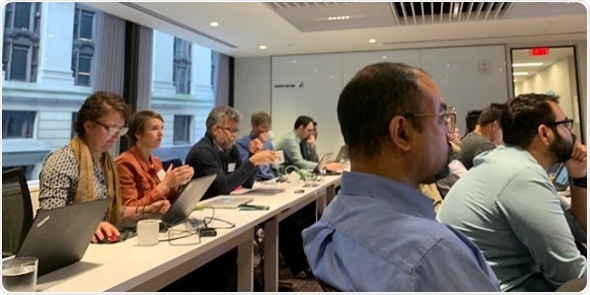The 3rd Annual Postnova Analytics Field Flow Fractionation (FFF) User Meeting was recently held on October 4, 2019 in Boston, MA (USA).

Attended by over 30 delegates the meeting featured scientific presentations from leading researchers in a variety of disciplines, informative talks from Postnova staff and stimulating discussion, which carried on during the outstanding seafood dinner
Paul Clarke of Postnova Analytics UK opened the event with a talk that explored a range of interesting applications addressed in the company's UK applications laboratory using FFF and size exclusion chromatography (SEC) with light scattering. One of the main applications discussed was the use of flow FFF coupled to multi-angle light scattering and dynamic light scattering to measure both the size and shape of polymer nanoparticles.
Jim Ranville of Colorado School of Mines presented his recent work on FFF coupled to inductively coupled plasma mass spectrometry (ICP-MS), in which he studied gold nanoparticles embedded in microplastic composites. This interesting study used both flow FFF and centrifugal FFF to measure the size and mass of these composite materials to calculate the number of gold nanoparticles present in each microplastic particle. This was used as a model system for studying the release of engineered nanoparticles embedded in a larger matrix, which is likely a more realistic release scenario than that of pure engineered nanoparticle release from nano-enabled products.
Onur Tasci of Harvard University presented his work on electrical FFF for the separation of sub-50nm particles and robotic manipulation of magnetic microbeads using 3D rotating fields. He demonstrated a video on how these magnetic microbeads can be made into larger assemblies which spin in the bloodstream in response to a magnetic field to destroy blood clots.
Robert Reed from Postnova Analytics USA presented the company’s new electrical asymmetrical flow FFF, or EAF4 system. After a short introduction to the principle of this exciting system, data was shown for a variety of applications including proteins, antibodies, and nanoparticles. Attendees were shown how EAF4 can be used to simultaneously separate particles by size while also measuring their electrophoretic mobility or zeta potential. This is especially useful in the case of multi-modal size distributions, where different size particles may have different surface charge characteristics, leading to differences in stability, cellular uptake, or other parameters.
A second talk from the team at Postnova Analytics USA was given by Soheyl Tadjiki, on quantifying the cargo mass of a drug delivery system by centrifugal FFF. This talk covered the principle of centrifugal FFF, which separates by mass, and the application of this technique to a current research topic. A recently developed method was used to quantify the number of RNA molecules in a lipid nanoparticle used as a drug delivery system, demonstrating the potential of centrifugal FFF to address one of the most challenging current research topics in nanomedicine.
Shoeleh Assemi from the University of Utah discussed the fate of silver nanoparticles in the presence of bovine serum albumin (BSA) using centrifugal FFF. She showed that the sorption of BSA on 60 nm citrate-stabilized silver nanoparticles decreased the particle mass with increasing BSA concentration in solution. This indicated that the silver nanoparticles are dissolving when BSA coats on the surface, an important result given that silver ions are thought to be responsible for silver toxicity and will be released in this scenario.
Finally, Ulf Nobbmann of Malvern Panalytical gave a talk on the principle and applications of dynamic light scattering (DLS), including “tips and tricks” on interpreting DLS data. He explained that one of the drawbacks of DLS is that polydisperse suspensions can be difficult or impossible to accurately characterize due to much more intense light scattering by larger sizes. Separating particles by size first with FFF, followed by in-line analysis by DLS, allows the accurate determination of particle sizes for the monodisperse fractions generated by FFF.